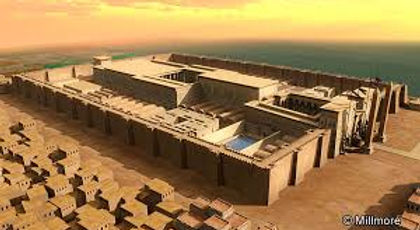<A>
Farnese Bull: * see EndNote<A>
This marble group, one of the largest marble statues recovered from Antiquity, is a Roman copy of a Greek original, perhaps made for the Baths of Caracalla, where it was found.

<B>
the Helios of Chares: *
Construction began 292 BC & was competed in 280. Accounts describe the structure as being built with iron tie bars to which brass plates were fixed to form the skin. The interior of the structure was filled with stone blocks as construction progressed & stood on a 50 foot high white marble pedestal near the Mandraki harbour entrance,. Some sources place the Colossus on a breakwater in the harbour. The iron & bronze used in construction was made from the various weapons Demetrius's army left behind & an abandoned siege tower may have been used for scaffolding around the lower levels. Upper portions were built with the use of a large earthen ramp; workers piled mounds of earth on the sides of the colossus. Upon completion all of the earth was removed and the colossus was left to stand alone.
BELOW LEFT- imaginative reconstruction of the Colossus of Rhodes
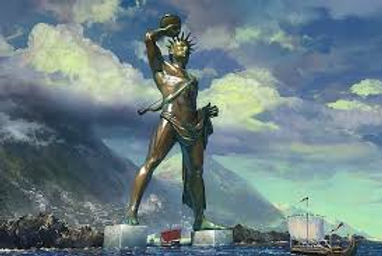
<C>
architecture of the Roman Imperial Age: *
Examples of some of the larger & more famous Roman buildings include:
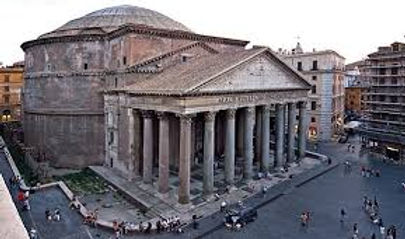

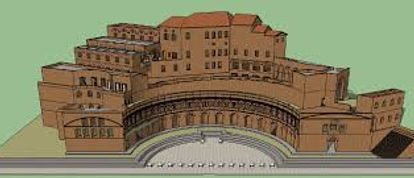
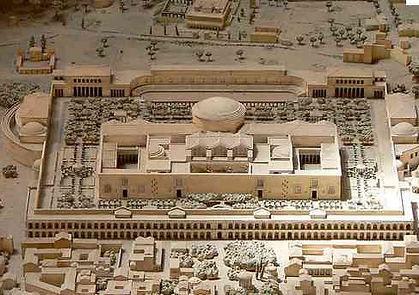

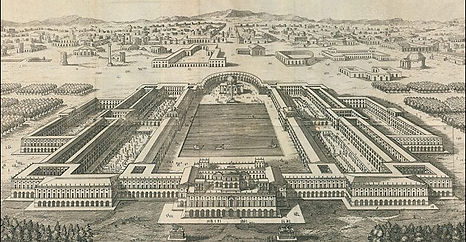
Pantheon temple of all the gods Roman temple, on the site of an earlier temple commissioned by Marcus Agrippa during the reign of Augustus (27 BC-14 AD), completed by the emperor Hadrian and probably dedicated about 126 AD. Its date of construction is uncertain, because Hadrian chose not to inscribe the new temple but rather to retain the inscription of Agrippa's older temple, which had burned down. The dome was the largest in the world for 1300 years & remains the largest unsupported dome in the world!
Vespasian’s Colosseum,(aka Flavian Amphitheatre) the largest amphitheatre ever built at the time and held 50,000 spectators; began under Vespasian in AD 72, completed in AD 80 under his successor, Titus
the Markets of Trajan, in Rome, Italy, located on the Via dei Fori Imperiali, at the opposite end to the Colosseum. The surviving buildings and structures, built as an integral part of Trajan's Forum and nestled against the excavated flank of the Quirinal Hill, present a living model of life in the Roman capital and a glimpse at the restoration in the city, which reveals new treasures and insights about Ancient Roman architecture. Trajan's Market was probably built in 100-110 AD by Apollodorus of Damascus, an architect who always followed Trajan in his adventures and to whom Trajan entrusted the planning of his Forum, and inaugurated in 113 AD
Baths of Caracalla Rome, Italy, the city's second largest Roman public baths, built between AD 212-16, during the reigns of emperors Septimius Severus & Caracalla. 1 of the 7 wonders of Rome. Olympiodorus of Thebes mentions a capacity of 1,600 bathers at any one time, with a daily capacity of 6,000 to 8,000 bathers.
The Basilica of Maxentius is an ancient building in the Roman Forum, Rome, Italy. It was the largest building in the Forum, and the last Roman basilica built in the city.
Domus Aurea (Latin, "Golden House") a vast landscaped palace built by the Emperor Nero in the heart of Rome after the great fire in 64 AD had destroyed a large part of the city & aristocratic villas on the Palatine Hill. It covered 300 acres (about 1/3rd of Rome), parts of the slopes of the Palatine, Esquiline, Oppian and Caelian hills, included a man-made lake in the marshy valley Finally Nero also commissioned a 116 foot high bronze statue of himself, the Colossus Neronis. It was completed in 68 AD; later the Coliseum was built on top of it.
<D>
architecture of the New Empire Egypt: *
The Ramesseum Temple in Luxor - Mortuary Temple of Ramses II; called the “million years temple” due to its huge surface area covering 50 thousand square meters & home to gigantic statues of Ramses II. The huge complex dedicated to the god Amun took 20 years and 10 of thousands of workers to build. It had 2 purposes: to enable the Egyptians to practice their religious rituals and secondly demonstrate the greatness of the Pharaoh, his political and military achievements. The Ramesseum Temple was made up by 2 huge walls, a huge inner wall surrounded the temple itself, an outer wall surrounded the storage rooms and smaller buildings of the temple. A corridor connected these 2 walls, was decorated with statues of sphinxes; the temple was home to 2 huge stone statues of Ramses II 18 meters high & weighting 1000 tons. The Ozymandias statue, half sunk, shattered visage, lying on the sand is an accurate description of part of the wrecked statue. The hands, and the feet, lie nearby. Were it still standing, the Ozymandias colossus would tower 62 ft above the ground, rivalling the Colossi of Memnon and the statues of Ramesses carved into the mountain at Abu Simbel. The hypostyle hall of the temple is supported with huge columns whose capitals are still well preserved & which show scenes from the Upper and Lower kingdoms of Ancient Egypt
LEFT reconstruction of Ramesseum Temple RIGHT digitally restored The Younger Memnon- 1 of the 2 Colossi that originally flanked the Ramesseum's doorway., depicts Ramesses II
